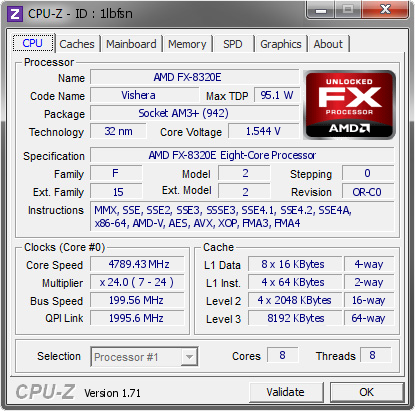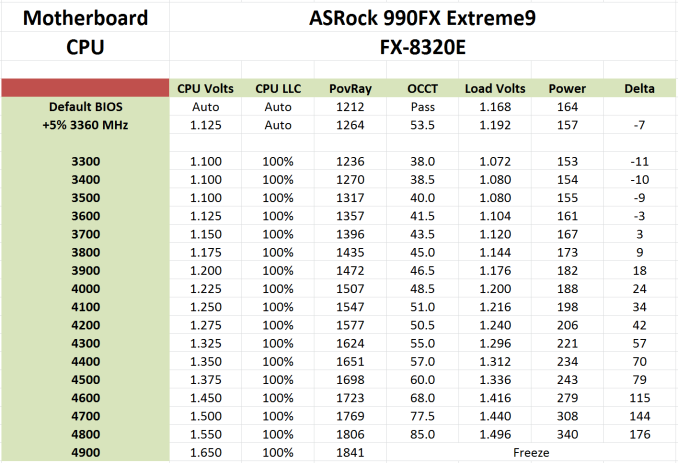AMD FX-8320E CPU Review: The Other 95W Vishera
by Ian Cutress on January 13, 2015 10:00 AM ESTAMD FX-8320E Overclocking
Sometimes looking at CPU overclocking performance is not that relevant. Each CPU ends up being different, and the plural of anecdote is not ‘data’. At some point it might be useful to sample 100+ CPUs of the same type and gain a proper scientific distribution of overclocks, but even then a sample size of 100 is quite small. So our single point in the ether might not matter too much, but the end result this time around was more than interesting.
To put this into perspective, our recent CPU samples here at AnandTech have been bottom of the barrel for our 24/7 validation methods. Our current i7-5960X does 4.4 GHz on a good day, and our fall-back stock testing model only does 4.2 GHz. Similarly we had an i7-4770K that only did 4.1 GHz – that was particularly shocking. Our last true good overclocker was a Sandy Bridge i7-2600K that did 5.3 GHz with a little push but sat at 5.1 GHz comfortably. Since then, horse plop is a nice word to describe it. However, that changed with our FX-8320E sample when paired with our AM3+ CPU test bed, the 990FX Extreme9.
As the voltage was increased, the frequency increased. It kept going, and going, and going. The Nepton 140XL CPU liquid cooler from CoolerMaster kept the temperature low (when I remembered to plug the fan in), but on the other hand the power started to rise. Almost every bump in frequency required an adjustment in voltage, but the increases were small.
At the end of the day, we rose from a 3.2 GHz base frequency all the way up to 4.8 GHz, a +50% overclock.
Methodology
Our standard overclocking methodology is as follows. We select the automatic overclock options and test for stability with PovRay and OCCT to simulate high-end workloads. These stability tests aim to catch any immediate causes for memory or CPU errors.
For manual overclocks, based on the information gathered from previous testing, starts off at a nominal voltage and CPU multiplier, and the multiplier is increased until the stability tests are failed. The CPU voltage is increased gradually until the stability tests are passed, and the process repeated until the motherboard reduces the multiplier automatically (due to safety protocol) or the CPU temperature reaches a stupidly high level (100ºC+). Our test bed is not in a case, which should push overclocks higher with fresher (cooler) air.
Overclock Results
The voltage at 4.8 GHz ran at an alarming 1.550 volts, and the system was stable during our testing when we rested all the benchmarks at this new marker. For 50% extra MHz, our POV-Ray scores jumped from 1212 to 1806, a near 50% jump as well. The only thing that jumped more than 50% was the power consumption. We measured an 86W idle to peak delta when at stock, but the final power was an additional +176W, or +205%, for a total 262W all in, pushing it above the FX-9590's TDP.
Actually in our graphs over the next few pages, the FX-9590 proved to be the best competition when overclocked. That being said, if I were using the CPU 24/7, 1.550 volts at 4.8 GHz would not be the best place to leave it. At 4.5 GHz the CPU only needed 1.375 volts for only a +79W power consumption. Depending on the power delivery of the motherboard, perhaps another couple of notches as well. But all four modules at 4.8 GHz was pretty much unexpected. As always, your mileage may vary.
One argument for our good overclocking sample takes many prongs. A cynic might suggest that this was pre-binned to give a good result, however our past samples from AMD has nothing to suggest that this was particularly special. Karma might suggest that it was just ‘our time’ to get a good sample. A pragmatist would suggest that the FX-8320E is a particularly highly binned part to begin with, and the 30W saving from the regular FX-8320 for only 300 MHz loss might work in its favor depending on how far the voltage curve goes. Again, as stated at the top of this page, it is hard to pin it down without a representative overclocking sample.
Test Setup
| Test Setup | |
| Processor | AMD FX-8320E 4 Modules, 8 Threads, 3.2 GHz, 4.0 GHz Turbo |
| Motherboards | ASRock 990FX Extreme9 |
| Cooling | Cooler Master Nepton 140XL |
| Power Supply | OCZ 1250W Gold ZX Series Corsair AX1200i Platinum PSU |
| Memory | G.Skill RipjawsZ 4x4 GB DDR3-1866 9-11-9 Kit |
| Memory Settings | XMP |
| Video Cards | MSI GTX 770 Lightning 2GB (1150/1202 Boost) |
| Video Drivers | NVIDIA Drivers 337 |
| Hard Drive | OCZ Vertex 3 256GB |
| Optical Drive | LG GH22NS50 |
| Case | Open Test Bed |
| Operating System | Windows 7 64-bit SP1 |
We are using our ASRock 990FX Extreme9 for testing consistency and comparison, despite AMD sampling the MSI 970 Gaming with this review unit. The motherboard and BIOS can affect the performance quite dramatically, and this keeps our numbers comparable to each other.
Many thanks to...
We must thank the following companies for kindly providing hardware for our test bed:
Thank you to OCZ for providing us with PSUs and SSDs.
Thank you to G.Skill for providing us with memory.
Thank you to Corsair for providing us with an AX1200i PSU.
Thank you to MSI for providing us with the NVIDIA GTX 770 Lightning GPUs.
Thank you to Rosewill for providing us with PSUs and RK-9100 keyboards.
Thank you to ASRock for providing us with some IO testing kit.
Thank you to Cooler Master for providing us with Nepton 140XL CLCs.
Load Delta Power Consumption
Power consumption was tested on the system while in a single MSI GTX 770 Lightning GPU configuration with a wall meter connected to the OCZ 1250W power supply. This power supply is Gold rated, and as I am in the UK on a 230-240 V supply, leads to ~75% efficiency > 50W, and 90%+ efficiency at 250W, suitable for both idle and multi-GPU loading. This method of power reading allows us to compare the power management of the UEFI and the board to supply components with power under load, and includes typical PSU losses due to efficiency.
We take the power delta difference between idle and load as our tested value, giving an indication of the power increase from the CPU when placed under stress.

86W undercuts the 95W TDP by a good margin, however one might suggest that the power efficiency difference of the power supply would take that into account. The stock load voltage was 1.168 volts in our motherboard, which does not suggest anything untoward regarding the VID.












92 Comments
View All Comments
xenol - Tuesday, January 13, 2015 - link
Since I can't seem to edit (or it's not made obvious)...I wanted to point out if a program is "single-threaded", it's using a synchronous threading model, where in threads will wait in line to be run. I'm pretty certain a lot of modern programs are asynchronous.
eanazag - Tuesday, January 13, 2015 - link
With an updated chipset and new manufacturing node, this CPU could still play in the market.At release the 900 series chipset was better than Intel's current solution which had no USB 3 and no SATA 3. It took a generation too long for Intel to catch up with SATA 3 (Sandy Bridge). At Ivy Bridge Intel passed AMD in every aspect.
We're talking Broadwell now and it is plain sad at this point. The Core i3's from Haswell beat the processor much of the time when not overclocked. The value proposition is not in AMD's favor unless some just wants to overclock something.
hojnikb - Tuesday, January 13, 2015 - link
>At release the 900 series chipset was better than Intel's current solution which had no USB 3 and no SATA 3Not really. 900 didnt have native usb3 (so pretty much the same deal as intel -- they had to use 3rd party solution). And in 2009, sata6g wasn't really a thing yet (no fast ssds back then).
hojnikb - Tuesday, January 13, 2015 - link
correction; 900 series was released in 2011, where sata6g ssds started to pop up...Laststop311 - Tuesday, January 13, 2015 - link
You just can't defend these FX line cpu's. You are a just a million times better off coughing up an extra 200 dollars and getting a nice z97 board + devils canyon i5 and overclocking it to an easy 4.4ghz. Even in software that can make use of all 8 cores for BD a 4.4ghz i5 devils canyon has a good chance of out muscling it or coming very close and for anything else the i5 just blows BD away.If you are going to buy an AMD FX based system just stop yourself and put 50 dollars away on your next 4 paychecks and get an i5-4690k + Z97 system instead and u will be much happier. Even if for some reason i had to have 8 cores in my next system i'd spend an extra 1400 or whatever and get an i7-5960x + x99 system. It's disgusting that an 4.0+ghz overclocked phenom II x6 1100t can outperform the new FX chips at MANY tasks and I would actually recommend an AMD buyer to just get an 1100t with quality water cooling over a current FX chip can find super cheap 1100t's which makes the 1100t + good water cooling the same price as a new FX + decent air cooler and u can just get better performance with the massively OC'd 1100t.
III-V - Tuesday, January 13, 2015 - link
>You just can't defend these FX line cpu's.Oh yes you can. There are thousands of people in the AMD Defense Force that do just this every day.
silverblue - Wednesday, January 14, 2015 - link
Haha I like this one. :)jabber - Thursday, January 15, 2015 - link
To me the difference is like going into a restaurant and ordering the AMD pizza which comes in at 15" for $20 or ordering the Intel pizza which is 18" and costs $5 more. Most people probably can't manage to eat the AMD let alone the Intel.It's not like we are back in the days with AMD stuck at 20 FPS average and Intel at 30FPS average.
Oxford Guy - Thursday, January 15, 2015 - link
That's a really awful analogy. If your primary taxing use for your computer is gaming then AMD processors are a poor option.jabber - Friday, January 16, 2015 - link
Not really."Oh noooo my $100 AMD chip is only giving me 86FPS!" How terrible!
How did we manage back in the 1990's.